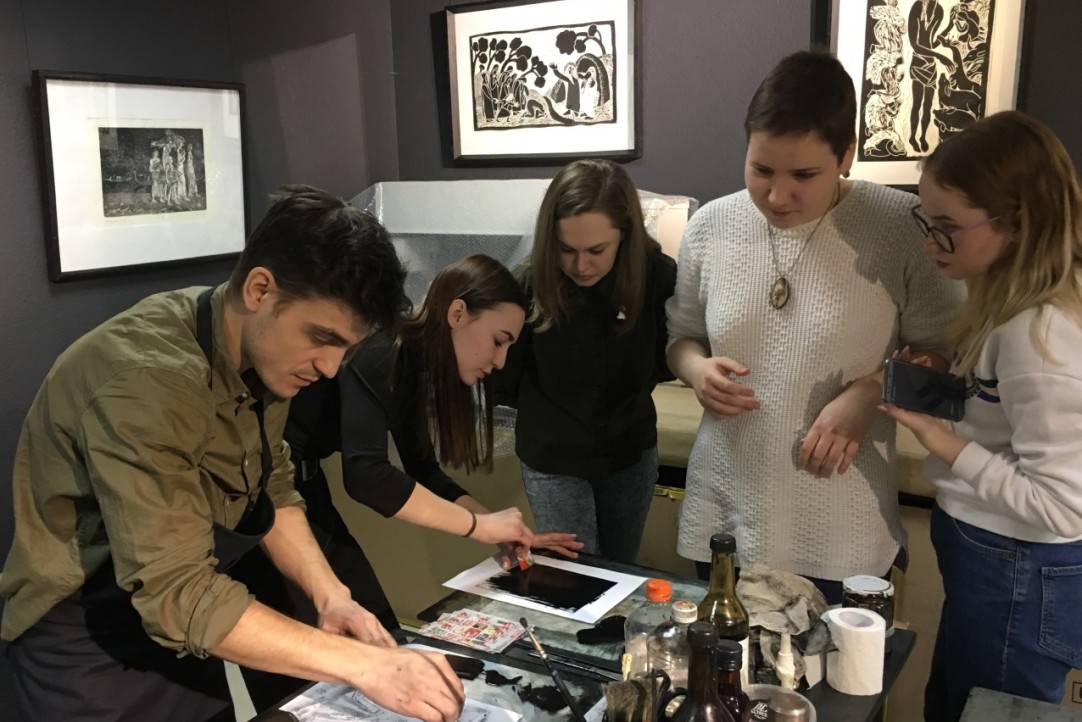Nizhny Novgorod Students Trade in Their Pens for Dry Needles to Create Graphic Literary Illustrations
Professor Valery Zusman’s class on comparative intermedia studies visited the Argento Gallery, where students used dry needles and an etching press instead of pens and pencils and a writing desk to create literary illustrations of the choice. For the course, which examines the interaction of various types of art, students will write essays about their graphic creations and the literary visions behind them.

Students chose a template among numerous book illustrations—from Pushkin’s Evgeny Onegin to Harry Potter. The artists Nikolay Vlasov and Yekaterina Glazunova helped the students cut sketches out of clear plastic sheets to be used as etching plates. Once ready, the pictures were printed on the etching press..jpg)
‘While I was planning the tutorial, I thought it would be great to leave the classroom, breaking away from the standard forms. Novelty for the sake of novelty is useless. But once we infuse it with a message we derive by studying comparativistics, it makes sense’, said Valery Zusman. ‘I wanted to analyze the history of literature through book illustrations to see how literary plots are reflected in etchings made by the students.’.jpg)
HSE University is famous for its project-based learning approach based on a solid theoretical foundation. That is why unique courses such as ‘Comparative Studies’ and ‘Metacomparative Studies’ by Valery Zusman take place in open cultural spaces, where students can create their micro-projects by themselves..jpg)
Leonid Groysman, Director of the Argento Gallery and an art photographer, pointed out that printed graphics, which used to bridge the gap between noble amateurs of fine arts and the general public, is being retransformed into an elite art form..jpg)
‘Something amazing happened in our consumerist society. Graphic art is once again a popular endeavor for the sake of artistic ideas rather than money. This time-consuming activity requires clear thinking and a certain maturity. That is where creativity blends with craftsmanship, and we see that one cannot exist without the other.
It is wonderful that in our crazy times there are activities in which students work with ancient art and craft forms. Students were able to create their works using a technique that has barely changed over the past 500-600 years.
The students were fascinated with the tutorial and agreed unanimously to decorate one of the HSE classrooms with their works..jpg)
‘This is the first time I’ve taken a class like this. A month ago, Valery Zusman invited us to an exhibition of Inessa Rakhmanova. We were shown a similar technique called linocut. Today, we have learned the dry needling technique. However, it is one thing to hear about a technique, and quite another to create something using it by yourself. This enables you not only to see a picture, but also to understand how it was created, learning each stage of the entire process. Although I didn’t seem to have a real flair for painting at school, today I learned that anything is possible if you are guided by great instructors and you work together with your classmates.’
Lada Zotova, a third-year student, Faculty of Humanities
‘I felt I was part of a creative act, and I experienced a childlike excitement. While we covered our works with ink, we felt like true artists. I wish we could have more classes like this! I created illustrations to my favorite book, Alice in Wonderland. I think I will enjoy writing an essay on this topic. With all this excitement, I can’t wait to put my thoughts on paper.’
Yekaterina Mirulyaeva, a third-year student, Faculty of Humanities
‘The subject is quite unusual and the format is unexpected. This is some sort of ‘meta-class’. I enjoyed it immensely, particularly because I have never been able to draw. I remember making carbon copies of comics in my childhood. I didn’t show my copies to anyone for some reason. Now, I want to show my work at an exhibition.’
Igor Zheleznyakov, a third-year student, Faculty of Humanities

